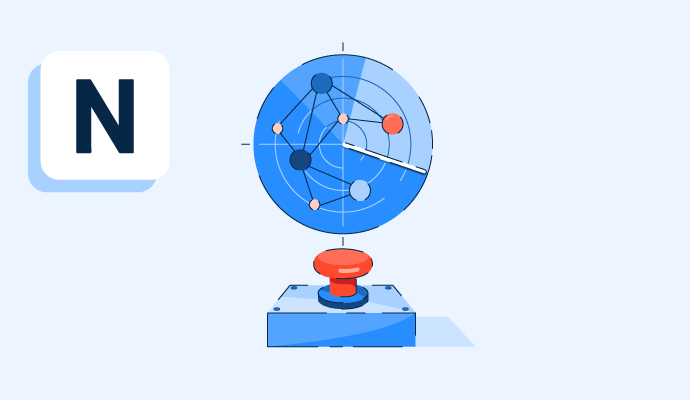What is network detection and response (NDR)?
Network detection and response (NDR) is a cybersecurity solution that monitors network traffic and detects suspicious activities. It helps companies consistently watch devices and technology connected to a network.
These devices include computers, printers, Internet of Things (IoT) devices, and other systems used in modern IT infrastructure. Network detection and response systems take advantage of advanced technological capabilities such as machine learning, deep learning, and threat intelligence to identify and mitigate cybersecurity risks.
Modern companies can make use of network detection and response software to catch security threats and alert relevant parties when needed. The software is well-equipped to automate threat remediation.
Types of threats NDR uncovers
The threat landscape evolves continuously. Threat actors craft new techniques to exploit a company’s security posture. Organizations must be cautious and vigilant since it's tricky to predict which type of threat will come knocking on the door. Below are some common threats NDR software is designed to catch.
- Unknown malware is hard-to-detect, malicious software. It compromises the host to gain control of the network.
- Targeted attacks involve social engineering, brute force attacks, distributed denial-of-service (DDoS) attacks, and other techniques to weaken endpoints.
- Insider attacks arise from within the organization. Employees or contractors may access, steal, or manipulate files, change access permissions, or install malware intent.
- Human error can inadvertently expose organizations to attacks. Sharing user credentials or giving someone privileged access by mistake can leave accounts vulnerable and lead to a larger attack.
Benefits of network detection and response
Network detection and response solutions look for suspicious behavior in the flow of traffic. If something is outside of normal, the software alerts relevant stakeholders. Other noteworthy advantages the platform offers users.
- Continuous network visibility. Professionals get uninterrupted network visibility, covering diverse device types and locations, including remote users, IoT devices, and cloud resources.
- AI-powered threat detection. Leading NDR solutions employ artificial intelligence (AI) and behavioral analytics to precisely model attacker behavior. It enhances threat detection and reduces false alarms.
- Enhanced SOC efficiency. AI-driven NDR automates security detections, aiding security operations center (SOC) teams in managing threats despite scarce cybersecurity expertise.
- Real-time attack response. NDR detects advanced attacks and responds in real time. It integrates with cybersecurity tools like endpoint detection and response (EDR) software and security orchestration automation and response (SOAR) software for a comprehensive security approach.
Common tools and techniques for network detection and response
Artificial intelligence equips NDR tools with several capabilities. They can identify and comprehend behavioral patterns. More on standard techniques and tools used in NDR is below.
- Machine learning (ML) analyzes large datasets to detect unknown threats using behavioral analytics. These models can identify unusual patterns in network traffic and detect threats.
- Deep learning is a subset of machine learning. It enriches NDR capabilities through artificial neural networks and analyzes network behavior.
- Statistical analysis uses past data and records to identify deviations from standard network traffic patterns.
- Heuristics spots suspicious characteristics in unknown threats.
- Threat intelligence feeds provide context for anomaly detection. It consumes data from external and internal sources to identify known threats.
- Signature-based detection methods use unique indicators of known threats to identify them in the future.
NDR threat prevention steps
NDR solutions follow the steps below to identify, detect, and prevent threats associated with suspicious network activities.
- Traffic monitoring. NDR solutions watch both inbound and internal network traffic for deep visibility.
- Advanced threat detection. NDR platforms employ AI, ML, and data analytics to analyze traffic in order to identify suspicious patterns continuously.
- Automated investigation. Patterns are extracted to detect suspicious connections and automate incident response.
- Intelligence integration. NDR tools detect potential threats and share this information with other security solutions.
- Alert feeds. Security alert feeds are created to inform SOC analysts about the network's security posture.
- Threat prevention. NDR blocks malicious traffic as it happens.
Best practices for NDR implementation
Stick to the following best practices to make the implementation effective and efficient.
- Define clear objectives. Clearly state deployment goals to align strategies with threat detection, incident response enhancement, or compliance adherence objectives.
- Assess networks. Conduct a comprehensive network evaluation, covering all environments to identify knowledge gaps.
- Customize rules. Tailor detection rules to specific security needs.
- Monitor the baseline. Establish a normal behavior baseline and monitor it all the time. Alert SOC when required.
- Integrate NDR. Security information and event management (SIEM) tools and endpoint protection tools integrated with network detection and response software centralize visibility and make incident response effective.
- Monitor in real time. Ensure real-time operation for continuous traffic analysis to enable swift threat detection and response.
Network detection and response vs. endpoint detection and response vs. extended detection and response
Network detection and response (NDR) offers real-time network traffic monitoring and analysis. It uses advanced technologies to see patterns and anomalies and catch suspicious activities.
Endpoint detection and response (EDR) monitors threats and mitigates them at an individual endpoint level. It provides visibility into endpoint activities to combat threats.
Extended detection and response (XDR) evolved from EDR and NDR to unify security detection from endpoints and network traffic. It refines real-time threat detection, investigation, response, and hunting, providing a comprehensive cybersecurity approach.
Learn more about XDR platforms and how they detect and remediate security issues.

Sagar Joshi
Sagar Joshi is a former content marketing specialist at G2 in India. He is an engineer with a keen interest in data analytics and cybersecurity. He writes about topics related to them. You can find him reading books, learning a new language, or playing pool in his free time.

